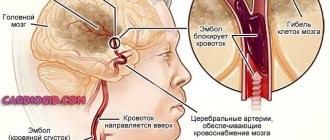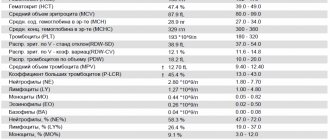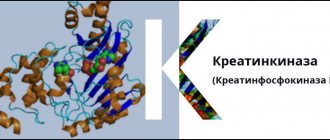From this article you will learn:
- What kind of analysis is this - blood hemogram
- How is a general blood test performed and a hemogram drawn up?
- How to decipher a blood hemogram: a table of normal indicators in an adult
- What do changes in blood parameters indicate?
- Blood hemogram indicators in children
A blood hemogram is one of the most common and simple tests that each of us encounters quite regularly. With the help of this study, you can obtain reliable information about the composition of the blood, making timely diagnosis of inflammation, the risk of anemia, etc. possible.
Essentially, a hemogram is a general blood test. Its decoding is a table that includes indicators of the levels of various blood components, etc. People who are far from medicine are often interested in how to interpret the values given in it. Let's figure out together what this research is.
Blood hemogram - what kind of analysis is it?
It is carried out for the purpose of:
- Detection of anemia, leukemia, lymphoma.
- Diagnosis of bleeding and bleeding disorders.
- Detection of viral and bacterial infections.
- Detection of polycythemia vera (polycythemia vera).
- Studies of lymphadenopathy (enlarged lymph nodes).
- Detection of various allergies.
- Analysis of splenomegaly (enlarged spleen)
.
- Detection of thalassemia.
- Monitoring the treatment of liver diseases.
Currently, venous blood is an ideal material for this type of research. What is this - a blood hemogram? This is a quantitative and qualitative analysis of individual blood structures (erythrocytes, leukocytes, platelets, etc.).
What does a blood hemogram show:
- This examination method makes it possible to identify the nature of the occurrence of certain symptoms of pathology after a specialist has studied the patient’s medical history and physical examination.
- In order to monitor changes in blood counts during chemotherapy.
When to do this analysis:
- After injuries accompanied by internal and/or external bleeding.
- In case of malaise, fatigue, bleeding, bone pain, swelling of the lymph nodes, infection, etc.
- At the preparatory stage before surgery.
- To assess the quality of blood after transfusions.
Decoding a blood hemogram provides information not only about the number of cells. It can also indicate the physical characteristics of some of them, which helps the doctor make an accurate diagnosis.
There are cases when the analysis indicators do not change even in the presence of any disease.
How is a general blood test performed and a hemogram drawn up?
How to donate a blood hemogram:
- It is determined from which vein the blood will be drawn.
- The elbow bend is treated with a swab moistened with an antiseptic.
- A not too tight tourniquet is applied to the arm just below the shoulder. You cannot tighten a limb for a long time.
- A vein is punctured.
- The required volume of blood is taken into a tube with EDTA.
- EDTA (ethylenediaminetetraacetic acid) is an anticoagulant needed to keep the blood fluid and not clot. The sample is then moved slowly around the tube several times.
- The material is sent to the laboratory.
The blood sample is examined in a special device called a hematology analyzer. The transcript of a blood test (hemogram) is a table containing the names of indicators, units of measurement, norms and actually detected deviations in the composition of the blood. They are identified by special markings or color changes.
The test results do not indicate diagnoses. It is transferred to the attending physician to make a final verdict (in conjunction with other studies, the patient’s complaints and his physical examination), since conclusions cannot be drawn only on the basis of the hemogram.
General information about blood tests
During the analysis, the number of formed elements in 1 ml of blood is determined and indicators are calculated that make it possible to indirectly judge the parameters of these cells.
A standard clinical blood test usually includes determining:
- number of leukocytes, platelets, erythrocytes,
- hemoglobin level,
- hematocrit (the ratio between the volume of formed elements and the total volume of blood),
- ESR,
- color index.
The expanded CBC is complemented by the calculation of erythrocyte, platelet and leukocyte indices.
Decoding the blood hemogram: table of normal indicators for an adult
- Erythrocytes are red blood cells that have a biconcave shape, small size and elasticity and ensure the passage of particles even in the narrowest capillaries. Their main function is to transport oxygen from the lungs to all organs and tissues of the body.
- Leukocytes are white blood cells that protect against infections, viruses and allergens. In addition, they “free” the body from cellular decay products.
- Platelets are the smallest cells that do not have a nucleus or color. This is one of the most important elements of blood, which is responsible for clotting. When the skin or organ tissue is damaged, platelets immediately “clog” the hole, forming a clot.
- Reticulocytes are “embryos” of red blood cells, capable of transforming into an adult cell under the influence of a special hormone.
- Eosinophils, basophils and neutrophils are types of white blood cells that perform a protective function against various types of bacteria and infections.
- Monocytes are large oval blood cells from the group of leukocytes with one nucleus. They do not contain granules (they are agranulocytes).
- Lymphocytes are a type of white blood cell. They are the main cells of the immune system, providing humoral (production of antibodies) and cellular (contact interaction with victim cells) immunity.
- Hemoglobin is a blood pigment, the main component of red blood cells. Its main function is to transport oxygen from the lungs to organs and tissues and remove carbon dioxide.
- Hematocrit is the ratio of plasma to formed elements, which allows us to determine the ability of blood to transport oxygen.
- ESR (erythrocyte sedimentation rate) allows you to estimate the ratio of plasma protein fractions.
- The color indicator of blood is the degree of saturation of red blood cells with hemoglobin.
Blood hemogram - interpretation in adults:
| Index | Norm |
| Red blood cells (RBC) | 4.3–6.2 x 1012/l – for men 3.8–5.5 x 1012/l – for women |
| Hemoglobin (HGB, Hb) | 120–140 g/l |
| Hematocrit (HCT) | 39–49% – for men 35–45% – for women |
| Red blood cell distribution width (RDWc) | 11,5–14,5 % |
| Mean erythrocyte volume (MCV) | 80–100 fl |
| Average hemoglobin content in erythrocytes (MCH) | 26–34 pg |
| Mean erythrocyte hemoglobin concentration (MCHC) | 30–370 g/l (g/l) |
| Platelets (PLT) | 180–320 x 109/l |
| White blood cells (WBC) | 4.0–9.0 x 109/l |
| Lymphocytes (LYM), % | LY% 25–40% LYM# 1.2–3.0 x 109/L (or 1.2–63.0 x 103/µL) |
| Content of a mixture of monocytes, eosinophils, basophils and immature cells (MID, MXD) | MID# (MID, MXD#) 0.2–0.8 x 109/l MID% (MXD%) 5–10% |
| Granulocytes (GRA, GRAN) | GRA# 1.2–6.8 x 109/L (or 1.2–6.8 x 103/µL) GRA% 47–72% |
| Monocytes (MON) | MON% 4–10% MON# 0.1-0.7 x 109/l (or 0.1–0.7 x 103/µl) |
| Erythrocyte sedimentation rate, ESR, ESR | Up to 10 mm/h for men Up to 15 mm/h for women |
Different laboratories may indicate different norms in the hemogram decoding forms. This is due to different methods for calculating parameters. Then the results should be interpreted based on the given standards.
Circumstances under which blood counts may change:
- Functional disorders in the human body that adversely affect the hematopoietic system.
- Bone marrow defects.
- Acute and chronic illnesses.
- Negative effects on blood cells outside the bone marrow.
A blood hemogram can be performed to prevent latent or indolent diseases, to confirm or refute a previously made diagnosis, to track the dynamics of the development of an already detected disease.
Recommended articles on the topic:
- How to massage the abdomen for weight loss: different techniques for health and beauty
- Stone massage: description, benefits, methods
- MRI of three parts of the spine: when is it necessary and what are the features of the procedure
General blood test: interpretation, table of normal values, preparation for donation
A clinical (general) blood test is a laboratory study of the qualitative and quantitative composition of a patient’s blood in order to diagnose and identify signs of infection and inflammatory processes in the body. A general blood test is always prescribed at the first sign of illness, but doctors recommend doing it for preventive purposes at least once a year. The results of the analysis are also entered into the sanatorium-resort card, therefore, without it, treatment in the sanatorium is not prescribed.
Subject of study and table of norms
To conduct a general blood test, venous or capillary blood is taken, which is examined for the levels of red blood cells, platelets, hemoglobin, the erythrocyte sedimentation rate, the number of leukocytes, hematocrit and a number of other parameters.
It is worth noting that for boys and girls under 12 years of age, the normal indicators are the same, and then a difference appears not only from the gender, but also from the age of the patient - when interpreting the results, the doctor always makes an allowance for this. When taking blood from a vein and from a finger, the results may differ slightly, so for a correct analysis of the dynamics, it is recommended to donate blood using the same method. Table of reference values for general blood test indicators
| Index | Designation | Norma (women) | Norma (men) | Units |
| Hemoglobin | HGB, Hb, hemohlobin | 117–155 | 132–173 | g/l |
| Average red blood cell volume | MCV, macrocytosis, normocytosis, microcytosis | 78–101 | 80–101 | fl |
| Distribution of red blood cells by volume | RDW, red cell distribution width | 11,6–14,8 | 11,6–14,8 | % |
| Total red blood cell count | RBC, red blood cells | 3,9–5,3 | 4,2–5,6 | million/µl |
| Total platelet count | PLT, PC, platelets, platelet count | 150–400 | 150–400 | thousand/µl |
| Erythrocyte sedimentation rate | ESR, ESR, ROE | 2–20 | 2–15 | mm/h |
| Hematocrit | HCT, hematocrit | 34–47 | 37–50 | % |
| Average erythrocyte hemoglobin | MCH | 27–34 | 27–35 | pg |
| Reticulocytes | RET | 0,5–1,2 | 0,5–1,2 | % |
| Total white blood cell count | WBC, white blood cells | 4,5–11 | 4,5–11 | thousand/µl |
| Leukocyte formula | ||||
| Neutrophils | NEUT | 47–72 | 47–72 | % |
| Lymphocytes | LYM | 19–37 | 19–37 | % |
| Monocytes | MON | 3–12 | 3–12 | % |
| Eosinophils | EO | 1–5 | 1–5 | % |
| Basophils | BAS | 0–1,2 | 0–1,2 | % |
Sanatorium
Tours
Flights
Transfers
Interpretation of a general blood test
Before moving on to describing the indicators of a general blood test, we emphasize that the information below is for informational purposes only and the results should be deciphered by a doctor. As a rule, diseases are complex in nature and simultaneously affect several blood parameters, the connection between which can only be made by a doctor. An attempt to engage in self-diagnosis is fraught with incorrect conclusions and, as a result, making decisions that are hazardous to health. Let us also pay attention to the fact that in 5% of healthy people, normal values may go beyond the accepted reference (statistical average) values.
Red blood cells
Erythrocytes - red blood cells - act as couriers in the human body. Due to their elasticity, they penetrate into vessels of any diameter and transport oxygen from the lungs to all organs and tissues, and transfer carbon dioxide in the opposite direction. These gases are added to hemoglobin contained in red blood cells.
High values of red blood cells in the results may indicate dehydration, blood diseases, heart and respiratory failure.
A low level of red blood cells is observed with blood loss, leukemia, lymphomas, congenital disorders of hematopoietic function, malignant tumors, hemolytic anemia, as well as with a deficiency of protein, iron and vitamins in the body.
Platelets
The main functions of platelets are blood clotting, the creation of blood clots, maintaining the tone of vascular walls and feeding capillaries.
A high level of platelets in the patient’s blood can be interpreted as a consequence of resection of the spleen, exacerbation of chronic autoimmune diseases, anemia of various origins, and inflammatory processes. The number of platelets tends to increase in the third trimester of pregnancy, in the postoperative period, with the development of erythremia and malignant tumors.
A low platelet count in the patient's blood may indicate hemophilia, drug-induced thrombocytopenia, systemic lupus erythematosus, renal vein thrombosis, the presence of a viral or bacterial infection, aplastic anemia, Fisher-Evans syndrome.
Hemoglobin
Hemoglobin levels are tested to evaluate the severity of anemia or polycythemia and to evaluate the effectiveness of treatment for these conditions. Hemoglobin is an iron-containing protein found in red blood cells that performs a gas exchange function.
An increase in hemoglobin is observed with dehydration, cardiac and pulmonary failure, overdose of diuretics, heart defects, various diseases of the blood and urinary system.
Anemia of various etiologies, blood diseases, blood loss, deficiency of proteins, vitamins and iron lead to a decrease in hemoglobin.
Leukocytes
Leukocytes - white blood cells - are produced by the bone marrow and perform a protective function in the human body. They help fight foreign objects in the blood, infections, foreign protein molecules, and dissolve damaged tissue at the stage of inflammation.
The number of leukocytes in a general blood test can increase for many reasons of different nature: it can be pregnancy, physical stress or eating before donating blood, vaccinations, systemic or local inflammation, trauma, burns, autoimmune diseases, conditions after operations, oncology, leukemia and leukemia.
The leukocyte count decreases due to viral infections, systemic autoimmune diseases, leukemia, radiation sickness, vitamin deficiency, as well as due to the use of cytostatics and steroids.
Leukocyte formula
The leukocyte formula is a description of the various forms of leukocytes in the blood serum, expressed either in quantity or as a percentage. The leukocyte population includes 5 types of cells: neutrophils, lymphocytes, monocytes, eosinophils and basophils.
Neutrophils are always represented in the greatest numbers; they are the first to “fight” the infection, surround and eliminate bacteria by phagocytosis. The most common cause of increased neutrophil levels in the blood is acute bacterial and fungal infections. Other possible causes of an increase in the number of neutrophils are systemic inflammatory diseases, pancreatitis, myocardial infarction, conditions after burns, and malignant bone marrow tumors. The number of neutrophils decreases with massive bacterial infections, sepsis, viral infections, aplastic anemia, and tumor metastases to the bone marrow.
Lymphocytes are indispensable tools of the immune system; without them, viruses cannot be destroyed and infection can be fought. B-lymphocytes “specialize” in producing antibodies, T-lymphocytes – in destroying infected cells, preventing the spread of infection, as well as identifying and destroying cancer cells. Acute bacterial infections, influenza, aplastic anemia, AIDS, systemic lupus erythematosus, some congenital diseases and taking prednisolone lead to a decrease in the level of lymphocytes. Infectious mononucleosis, rubella, chickenpox and other viral infections, malignant tumors of the bone marrow and lymph nodes, as well as some bacterial infections lead to an increase in the level of lymphocytes.
monocytes in the blood, but they perform an important protective function. Monocytes have the ability to turn into macrophages, destroying damaged cells and retaining foreign proteins on their surface, thereby facilitating the work of lymphocytes. A decrease in the number of monocytes usually indicates aplastic anemia or accompanies treatment with prednisolone. An increase in the concentration of monocytes manifests itself in acute bacterial infections, tuberculosis, syphilis, sarcoidosis, connective tissue diseases, and oncological diseases of various localizations.
eosinophils in the blood relative to other leukocytes, and they also have the ability to phagocytose, but their main task is to fight parasites and regulate allergic reactions. An increased level of eosinophils accompanies allergic diseases (bronchial asthma, eczema, food allergies), allergic reactions to medications and infection with parasitic worms. Much less frequently, an increase in the number of eosinophils can be explained by the development of malignant tumors in the bone marrow and lymph nodes, systemic connective tissue diseases, or Lefler's syndrome. The number of eosinophils decreases during treatment with prednisolone, with Cushing's and Goodpasture's syndromes, as well as with acute bacterial infections.
basophils release histamine, a substance that causes allergy symptoms (itching, burning, redness). The concentration of basophils in blood test results decreases during the acute phase of an infectious disease, hyperthyroidism, and prolonged treatment with corticosteroids. An increase in the content of basophils is rarely observed, for example, with cancer of the bone marrow and lymph nodes, polycythemia vera, and some allergic diseases.
Reticulocytes
Reticulocytes are young red blood cells produced by the bone marrow. A quantitative study of reticulocytes in the blood provides insight into how adequately the bone marrow is producing red blood cells. The level of reticulocytes may deviate from the norm due to third-party reasons, such as: climbing to high altitudes, scuba diving, smoking, pregnancy, taking medications.
An increase in reticulocytes in the results of a general blood test is caused by bleeding, hemolysis, inflammation, cancer, polycythemia of various etiologies, the consequences of radiation therapy and chemotherapy, and side effects from the treatment of anemia.
Having detected a low level of reticulocytes in the results, the doctor may suggest iron deficiency, B12 deficiency or folate deficiency anemia, thyroid disease, aplastic anemia, kidney disease, chronic infections, uremia.
Hematocrit
Hematocrit, measured as a percentage, is the ratio of the volume of red blood cells to the volume of the liquid component of blood. An increased hematocrit is detected in iron-, B12- and folate-deficiency anemia, bleeding, impaired hemoglobin synthesis, liver cirrhosis, hemolysis, malignant tumors, or due to intravenous administration of significant volumes of fluids. A low hematocrit usually indicates dehydration, but can also be a sign of congestive heart failure, COPD, or polycythemia vera.
Erythrocyte sedimentation rate (ESR)
This test is designed to evaluate how quickly the blood separates into plasma and red blood cells. The test results are used to diagnose diseases associated with acute or chronic inflammation, including cancer, infections and autoimmune diseases. Infectious and inflammatory diseases, connective tissue diseases, cancer, myocardial infarction, anemia, burns and injuries increase the ESR value, while a decrease in ESR is usually caused by polycythemia and diseases associated with changes in the shape of red blood cells.
How to prepare to donate blood
- The day before the scheduled time of blood donation, stop drinking alcohol.
- It is recommended to avoid taking medications one day before blood sampling (requires separate approval from your doctor).
- 8 hours before the study, refuse to eat, drinking still water is allowed.
- Half an hour before donating blood, avoid physical and emotional stress.
- Also, stop smoking half an hour before the test.
Support
Are you not sure what criteria to use to choose a resort or sanatorium?
Don't know how to book?
Call us and our support staff will help you.
FAQ
Evgeniy Korostelev
Head of Help Desk
Help Desk Presentation
From Germany
+4974328093002
From other countries
+420355455981
The doctor's consultation
Free help from a health resort doctor
If you find it difficult to independently search for a resort and sanatorium that is optimally suited for treating your diseases, then take advantage of a free consultation with a health resort doctor Elena Khorosheva.
Submit your question here
Elena Khorosheva
Chief physician sanatoriums.com
Presentation by doctor Elena Khorosheva
From other countries
+420355455981
What do changes in blood parameters indicate?
Deviation of the blood hemogram from the norm in the table:
- A reduced level of hemoglobin is observed in anemia, leukemia, severe blood loss, pregnancy, congenital diseases of the circulatory system, and lack of iron and vitamins.
- Hemoglobin increases with congenital pathologies of the heart or lungs and their insufficiency, while at altitude, with dehydration caused by impaired renal function, diabetes mellitus and diabetes insipidus, vomiting or diarrhea, low fluid intake or heavy sweating.
- An increased level of leukocytes is observed in cases of cancer, purulent-inflammatory processes, burns or other injuries during which the soft tissues of the body are damaged.
- An increased number of lymphocytes indicates infection with any viruses, and neutrophils indicate bacterial infections. Eosinophils are considered to be markers of parasitic infestations and allergic reactions.
- An increased number of platelets occurs in chronic inflammatory diseases (tuberculosis, ulcerative colitis, cirrhosis of the liver), after operations, treatment with hormones, in some types of cancer, and iron deficiency anemia.
- A decrease in the number of platelets indicates heavy metal poisoning, blood diseases, kidney failure, pathologies of the liver, spleen, and hormonal disorders.
In addition, most drugs affect the results of laboratory tests of the above indicators.
We recommend
Therapeutic massage for the back: features, indications and contraindications Read more
Reasons that may affect the tests:
- The tourniquet was applied incorrectly when drawing blood or the application time was exceeded.
- Shaking the test tube.
- Insufficient amount of blood taken for testing.
- Mixed-up tubes with samples from different patients.
- The test tube filling standards were not met.
- Long-term storage of the collected blood sample.
- Biochemical parameters are disturbed.
- Blood is taken after the transfusion procedure.
- Technical failure of the equipment.
If the decoding of the hemogram does not correspond to the patient’s complaints and the results of the physical examination performed by the doctor, then an extended study is prescribed.









